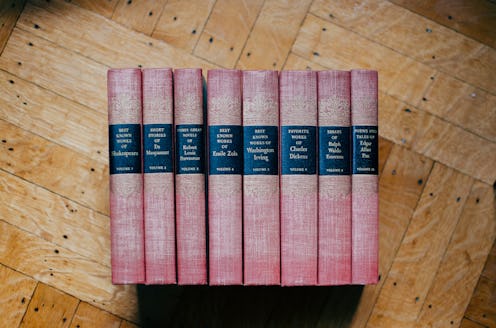Book nerds love "old book smell," but what do old books smell like, exactly? As it turns out, they smell like your favorite things: chocolate and coffee.
Wait, what? I've always thought of old books as having a musty, earthy smell, like a nice patch of moss or an undisturbed basement. When I give an old book a sniff, I smell soil and dampness and a little bit of biting spiciness.
Apparently, I'm in the minority here.
Researchers at the University of London's Institute for Sustainable Heritage published "the Historic Book Odour Wheel, a novel documentation tool representing the first step towards documenting and archiving historic smells," in the journal Heritage Science. The wheel divides old book smell into eight categories — Chemical/Hydrocarbons, Earthy/Musty/Mouldy, Fishy/Rancid, Fragrant/Vegetable/Fruity/Flowers, Grassy/Woody, Medicinal, Smoky/Burnt, and Sweet/Spicy — then divides each of those into 2-6 subcategories, such as Ash, Engines, Mothballs, or Vanilla.
The Historic Book Odour Wheel isn't just for fun, though. It can actually help archivists identify whether books are in danger of disintegrating, or if there happens to be something destructive in their environment.
See, old book smell is caused by the degradation of Volatile Organic Compounds (VOCs) in the paper, ink, and glue used in the book-making process. These compounds have unique chemical signatures that give off smells we can relate to ordinary things, such as grass or vanilla. An ordinary person can't tell you what undecanal smells like, but they can sniff out chocolate from a mile away. Thus, having a tool like the Historic Book Odour Wheel can be helpful to people who want to preserve centuries-old books, and for those of us who just want to know why our vintage hardcovers smell like gasoline.
But how did researchers determine that old books smell like chocolate and coffee? By asking people to sniff them, of course! As part of an event at the Birmingham Museum and Art Gallery, 79 visitors provided 120 descriptors for an unlabeled sample of old book smell. Their responses were used to generate a word cloud, which showed that chocolate and related terms came to most folks' minds with 27 mentions. Coffee was the next runner-up with 10 mentions.
These descriptors may have been slightly compromised, according to researchers, because the names of seven other smells in the exhibit popped up among responses to old book smell:
Since the historic book smell was one of eight odours presented to the visitors during the exercise, it is possible that some of the descriptors for this smell were contaminated through sampling the other aromas, which included ‘chocolate’, ‘coal fire’, ‘old inn’, ‘fish market’, and ‘dirty linen’, coffee and HP sauce.
However, chocolate and coffee have VOCs similar to those found in old books, so the museum visitors' responses are probably more accurate than not.
